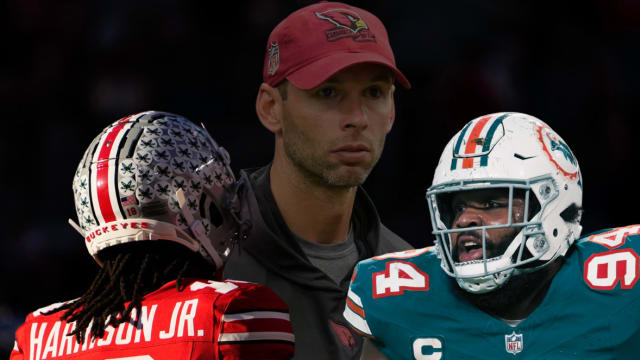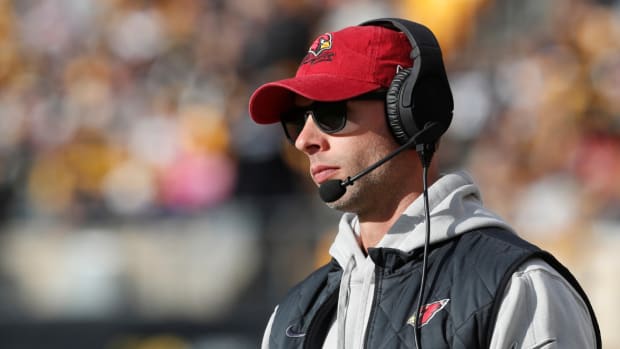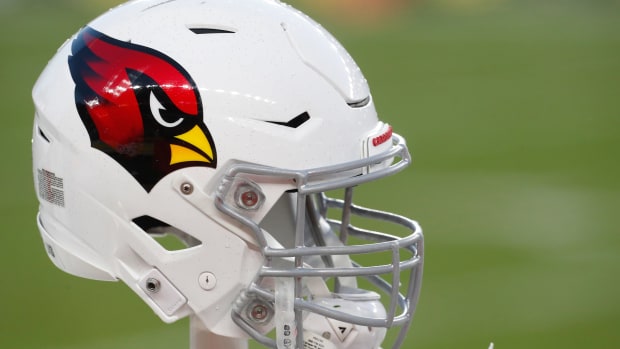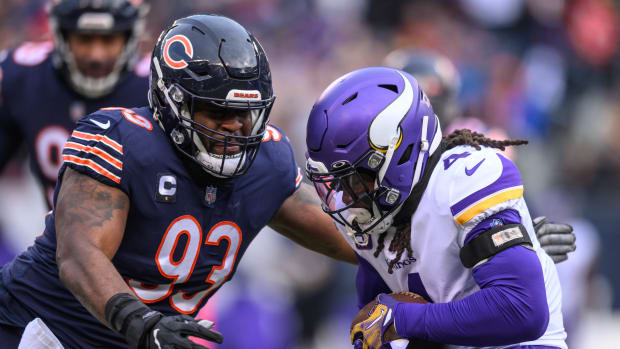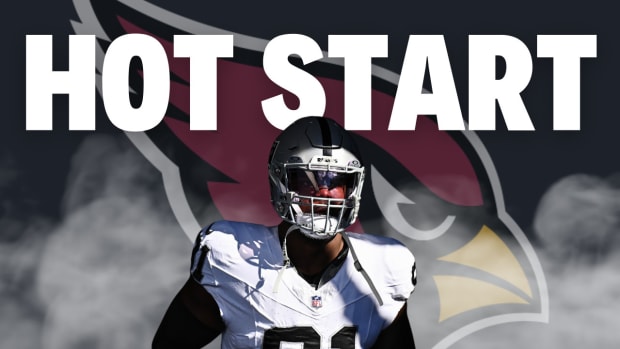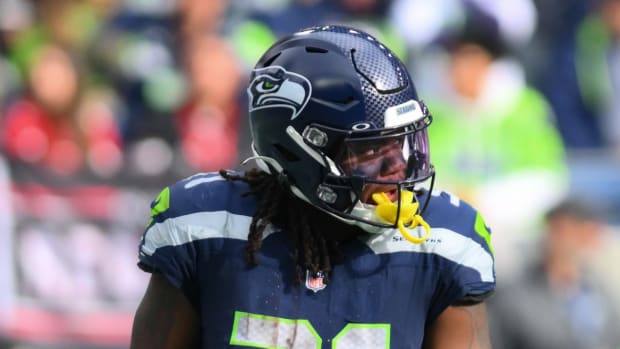
Breaking Down Cardinals' Best WR Options
ARIZONA -- It's no secret the Arizona Cardinals are in dire need of some support in the WR department. Although many a Cardinal fan--and media member--might be looking for the team to draft a certain legacy player out of Ohio State, the truth is there is a large number of options to fill the need in both the draft and free agency.
Here is a breakdown of some of the top receiver options, with pros and cons to go along with them.
The Draft Class
This is a loaded draft at the receiver position. While one certainly might boast the name-brand and legacy that the Cardinals and their fans desperately want, there are multiple solid options if Arizona wants to go for a playmaker early in the draft.
Here are the top three receiver options in the 2024 NFL Draft
1: Marvin Harrison Jr., Ohio State University
Let's get this one out of the way. Harrison is one of the best players in the 2024 NFL draft. He's far and away the #1 option for Arizona, coming off back to back brilliant receiving seasons.
In 2023, he was the Biletnikoff award winner. He hauled in 67 passes for 1,211 yards and 14 touchdowns. He averaged over 18 yards per reception, and produced at an insane rate despite a significant downgrade in who was throwing him the ball, going from young stud C.J. Stroud to a shakier Kyle McCord.
Pros: There's not much of a weakness to Harrison's game. At 6-foot-4, 205 pounds, he'd be a necessary big target with good speed and footwork who can work the entire field. On top of his athleticism and production, he brings a humble, hardworking personality and instant star power to a Valley that's been starved of such an influence since the prime years of Larry Fitzgerald. Harrison is a slam dunk pick in nearly every aspect of the game, and is the most polished, NFL-ready receiver in the draft.
Cons: Despite the fact that he might look like the "perfect" pick, the truth is it could still prove difficult to land the stud out of Columbus. While many are projecting the quarterback class to go 1-2-3, all three teams ahead of Arizona are wild cards. While it would make logical sense for each one to take a QB, the #4 pick is like a multi-faceted parlay, where each leg might have favorable odds, but you need all of them to go your way at once. It's not out of the question that Harrison will be there, but there are too many moving parts to completely rule out the big WR going in the top three.
2: Rome Odunze, University of Washington
Odunze had a monstrous 2023 season in Seattle. Serving as QB Michael Penix Jr.'s primary deep target, he put together 10 games of 100+ yards with UW, and was an x-factor for the Huskies' killer air system all year.
He notched an exceptional 92 receptions, for an astonishing 1,640 yards and 13 touchdowns, putting up 17.8 yards per reception. He showed excellent chemistry with Penix, and was not only able to make plays down the field, but was also reliable in clutch, short-field moments.
Pros: Odunze's stock has been steadily raised each season. He also sports a big frame, at 6-foot-3, 215 pounds. He was excellent on contested catches (a huge gap in Arizona's offense), with a great feel for the holes in the secondary and precision routes. His ability to build a relationship with his QB and be there in clutch downs is encouraging, and he could form a brutal duo with Kyler Murray in the white and red.
Cons: Odunze is a bit of a late bloomer, and benefitted from playing in a Pac-12 that isn't known for elite defenses. Putting up huge numbers in an offense-heavy conference could mean some empty calories. Odunze isn't known for a quick release, and while he was brilliant on contested catches, he wasn't able to create instant separation or utilize elite speed to blow past a secondary.
3: Malik Nabers, Louisiana State University
Nabers was LSU's biggest weapon in 2023. Working with star QB Jayden Daniels, he put up excellent numbers in his junior year. He's somewhat smaller than the other guys, measuring out at 6 feet, 200 pounds.
Nabers caught 89 balls, for 1,569 yards and 14 TDs, another average north of 17 yards per catch. He put together an exceptional season in a big-time LSU offense, including an incredible 239-yard performance against Mississippi State.
Pros: Nabers could bring explosiveness and versatility to the Cardinals' offense. He has the ability to play anywhere on the field, including in the slot, and has the blinding speed that some of these other prospects might not bring. He has a quick release, great footwork early in routes, and an ability to turn shorter receptions into massive YAC situations.
Cons: Nabers might profile as one of the less NFL-ready receiver prospects, at least for the early round picks. He isn't a huge contested catch winner, and might be best suited to a slot role due to a lack of being a vertical threat. Nabers could end up being a classic case of a college receiver who isn't blessed with the natural feel for a defense and relied primarily on athleticism to extend plays, which might not translate well to the NFL.
Free Agency
The Cardinals have a lot of positions of need. This allows them to utilize their draft capital however they see fit, and generally speaking, general manager Monti Ossenfort will have a difficult time making a "bad" pick at #4, #27, or even in later rounds.
The Cardinals could find themselves without MHJ, and could opt to fill another need in the draft. The WR market in free agency is a bit more limited, but here are three of the top options to address the WR position outside of the rookie class.
1: Tee Higgins, Cincinnati Bengals
Higgins is the top-ranked free agent WR in the NFL. He worked through a down year in 2023, due to injury and the Bengals' rough QB situation, putting up his career-low in receptions, yards and touchdowns.
Over 12 games, he caught 42 passes for 656 yards and five touchdowns, coming out to 15.3 yards per reception. This down year, in which he missed five games, was still a better stat line than any Cardinals receiver in 2023.
Pros: Higgins is a big, physical receiver, sitting at 6-foot-4, 219 pounds. He brings an ability to bring down contested catches with his large frame, with an exceptional penchant for high pointing balls and bringing in catches in traffic. His hands and strength are elite, and he could be that big downfield target the Cardinals need. He had 1000-yard receiving seasons in each of his previous two seasons, and was quite close to that mark even in his rookie year. He's consistent in his level of production, and generally stays healthy outside of 2023.
Cons: Higgins isn't an elite route runner, and doesn't bring exceptional speed. He's also never been a true WR1, and likely benefits from Ja'Marr Chase as Cincinnati's elite top target. He's a guy you can rely on for 50/50 balls, but doesn't bring that full field agility or versatility in his route tree, and is a mostly one-trick type player. He's also projected to receive over $20 million for a one-year deal, a steep price for a Cardinals team with so many needs to fill.
2: Calvin Ridley, Jacksonville Jaguars
Ridley came back from his 2022 suspension with a solid 2023 campaign. He's produced at a solid rate nearly every full season he's played, and was able to put up nearly 1,400 yards in Atlanta, who's been starved for elite QB play for a while.
He caught 76 passes in 2023, for 1,016 yards and eight touchdowns, and was a reliable target for multiple QBs.
Pros: Ridley has good speed and release, and an ability to separate quickly from DBs. He's able to work all areas of the field and can be both a slot threat and a vertical threat. He's got a nose for the end zone and could be a key contributor in red zone possessions, an area where the Cardinals have struggled for years.
Cons: Ridley doesn't bring the size that Arizona is likely looking for. While he does measure north of six feet, he's only 190 pounds, and can be redirected by physical DBs, not to mention a slight drop problem due to an inability to make body catches. He's also had some issues with injury and mental health struggles, and his suspension for betting on NFL games could be a big red flag for Ossenfort and Gannon.
3: Michael Pittman Jr., Indianapolis Colts
Pittman also suffered from a tough QB situation in Indianapolis, but still put up a career high stat line. At 6-foot-4, 223 pounds, he's a monster target with plenty of consistency.
He hauled in 109 receptions in 2023, going for 1,152 yards and four touchdowns. He was the clear Colts WR1, and has been a reliable target regardless of who is throwing him the ball.
Pros: Another huge, physical receiver to add to Arizona's size-challenged corps. Pittman has consistency, excellent hands, great contested catches and an ability to box out defenders with his frame. His strength, intellect and persistence allow him to chip away at defenses and provide mismatches with most cornerbacks. He can work the middle of the field or underneath at an impressive rate and be a reliable third-down target for Kyler Murray.
Cons: Pittman doesn't have exceptional speed or release, and he tends to get checked in press coverage easily. His footwork is understated, and his lack of ability to beat DBs off the release means he won't be a huge vertical threat. Add all of this to a projected $20 million paycheck, and he might not be a realistic option for the Cardinals.
The Cardinals are in a unique spot. While any of these receivers could elevate the offense, each comes with their own upside and weaknesses. The Cardinals likely sit in another "can't go wrong" situation, but it might be hard to envision Ossenfort forking over a huge contract to a receiver with question marks.
The Cardinals will not be wanting in receiver talent for lack of options in 2024, it's only a matter of the right fit.

